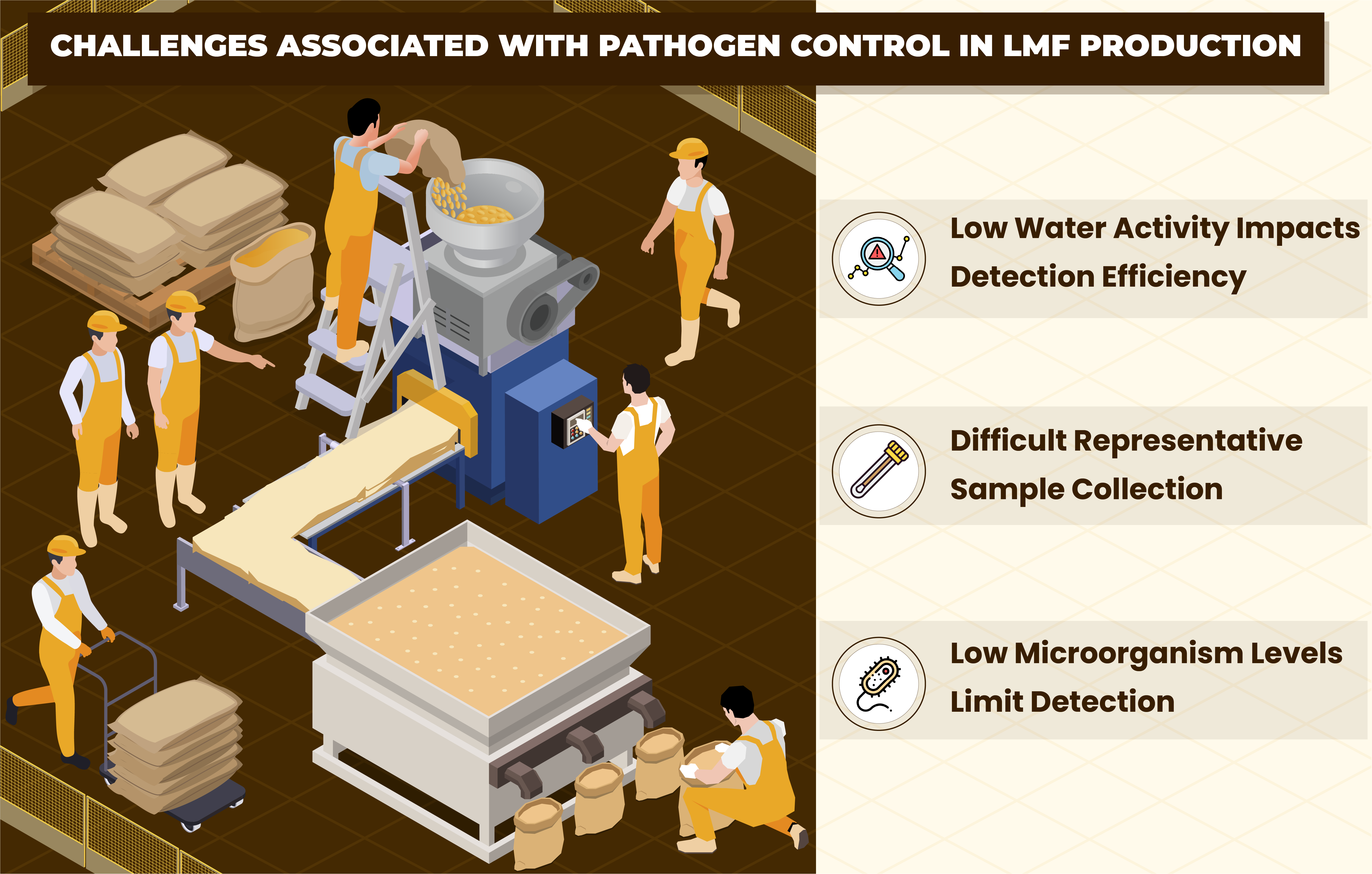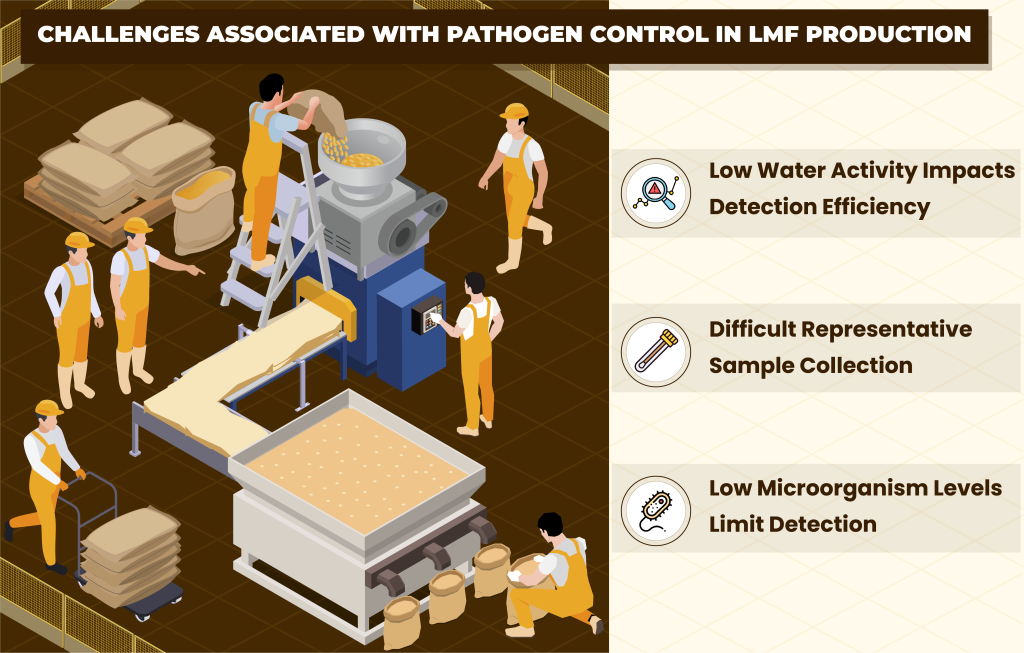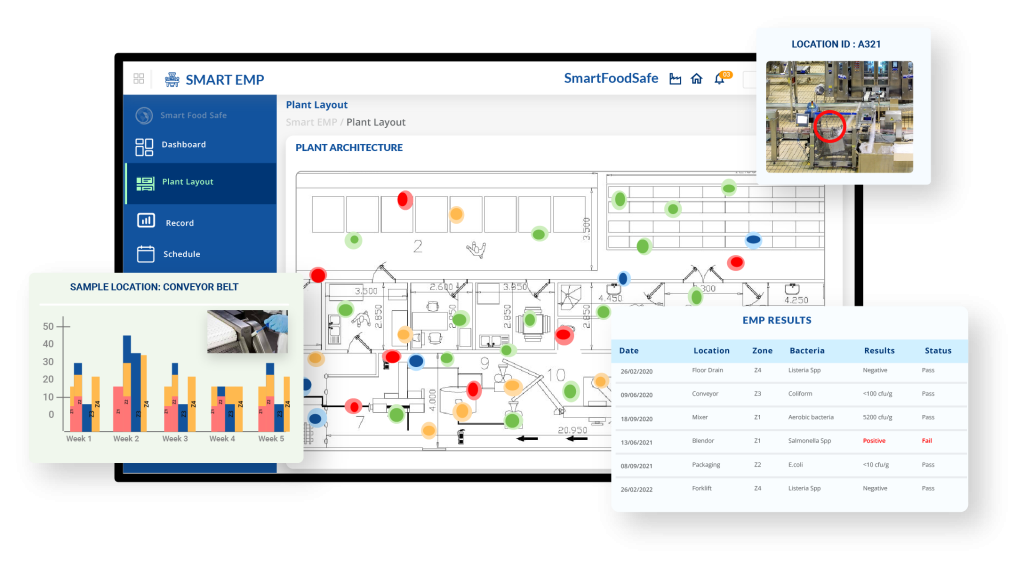
While the presence of microorganisms is a concern across all food production environments, low-moisture foods (LMFs) present unique challenges. Despite their low water activity, which typically limits microbial growth, LMFs can harbor pathogens that remain viable over extended periods, leading to serious foodborne illnesses. Detecting these microorganisms in low moisture environments is essential for mitigating risks and safeguarding public health.
The detection of microorganisms in low-moisture food production environments requires specialized techniques due to the specific properties of these environments. Traditional detection methods often face limitations, necessitating the adoption of more advanced and targeted approaches.
Comprehending Low Moisture Foods (LMFs) & Its Production Environment
Low Moisture Foods (LMFs) are food products characterized by low water activity (aw), typically below 0.85. Water activity measures the availability of free water in a product, which is important for microbial growth. Foods with low water activity include products like nuts, cereals, dried fruits, powdered milk, spices, and pet foods. Due to their low moisture content, these foods are less prone to spoilage by bacteria, yeast, and molds, but they can still harbor harmful pathogens like Salmonella and Cronobacter sakazakii.
Characteristics of LMFs:
- Extended Shelf Life: LMFs have a longer shelf life due to reduced microbial growth.
- High Risk of Contamination: Despite the reduced water activity, LMFs are at risk of contamination because certain pathogens can survive in these conditions for extended periods.
- Consumption Without Further Processing: Many LMFs are ready-to-eat products, meaning they are consumed without further cooking, which increases the risk of foodborne illness if they are contaminated.
An LMF production environment refers to the particular conditions under which low-moisture foods are processed and manufactured. These environments are designed to maintain the low moisture content of the food products and prevent any increase in water activity that could lead to microbial growth.
Characteristics of LMF Production Environment:
- Controlled Humidity and Temperature: The production environment is typically kept at low humidity levels to maintain the low moisture content of the food products. Temperature control is also significant, as higher temperatures can increase water activity and promote microbial growth.
- Sanitation and Hygiene: Due to the high risk of contamination, LMF production environments require stringent sanitation and hygiene practices. This includes regular cleaning of equipment, surfaces, and production areas to minimize the presence of microorganisms.
- Specialized Equipment: Equipment used in LMF production is designed to handle dry products and minimize the introduction of moisture. This includes conveyors, mixers, and packaging machines that are tailored to the specific needs of low-moisture foods.
- Risk of Cross-Contamination: LMF production environments must be designed to prevent cross-contamination between raw and finished products. This includes implementing physical barriers, air handling systems, and proper flow of materials and personnel to reduce the risk of contamination.
Pathogens of Concern in Low Moisture Foods
| Pathogen | Key Elements Relevant to LMF Conditions | Control Options |
|---|---|---|
| Salmonella species May 22, 2024 |
|
|
| Cronobacter spp. |
|
|
| Escherichia coli (E. coli) |
|
|
| Bacillus cereus |
|
|
| Listeria monocytogenes |
|
|
Pathogen Control Challenges in LMF Production Environments
-
Environmental Factors
Low-moisture food production environments are typically characterized by dry conditions, which can make the detection of microorganisms particularly challenging. The low water activity not only inhibits microbial growth but also impacts the efficiency of detection methods.
-
Sample Collection Difficulties
One of the primary challenges in detecting microorganisms in low-moisture food environments is the collection of representative samples. Swabbing is a common method for collecting surface samples, but its effectiveness can be compromised by the dry nature of the surfaces and the low concentration of microorganisms.
-
Detection Limitations
Microorganisms in these environments may adhere more strongly to surfaces or become embedded in product matrices, making them harder to detect using conventional methods. The low levels of microorganisms present in these environments may fall below the detection limits of these methods. Moreover, certain pathogens may enter a viable but non-culturable (VBNC) state in low moisture conditions, rendering them undetectable by standard culture techniques.
Digital Processing Environment Monitoring (PEM) for Better Pathogen Control in LMF Industry
Processing Environment Monitoring (PEM) is a critical practice in food safety that involves the systematic assessment of production environments to ensure the absence of harmful microorganisms. A digital approach to this operation further reinforces the precision and effectiveness of a PEM. It serves two primary purposes:
Ongoing Hygiene Assessment – By testing for “hygiene indicator” microorganisms—such as aerobic mesophilic counts, Enterobacteriaceae counts, and yeast and mold counts—manufacturers can gauge the overall hygiene status and effectiveness of cleaning procedures. This type of monitoring is crucial for identifying potential microbial contamination before it affects product safety.
Pathogen Detection & Control – PEM also focuses on detecting specific pathogens relevant to the products being manufactured. The choice of pathogens tested depends on the intended use of the food products and their associated risks.
Incorporating molecular methods for pathogen detection into a digitalized routine processing environment monitoring program, designed to include regular sampling of both product contact and non-product contact surfaces, can enhance the control of pathogens in low moisture environments.
Key Elements of an Effective Digital PEM Program
An effective digital PEM program should be designed with the following key elements:
- Risk-Based Approach: Begin with a comprehensive, digital risk assessment to identify microbial hazards specific to your products. Utilize advanced analytics to assess potential contamination sources within the production environment, prioritizing microorganisms that pose the highest risk to human health.
- Categorization of Sampling Points: Digitally categorize sampling points based on their proximity to food products and hygiene zones. Use this digital mapping to prioritize monitoring areas, enabling targeted, data-driven sampling strategies. Critical sampling sites include food contact surfaces (Zone 1) and adjacent non-food contact surfaces (Zone 2).
- Sampling Protocol: Establish a clear and detailed sampling protocol for identifying specific sample locations, determining the frequency of microbiological tests, and specifying the target organisms to be monitored.
- Special Circumstances Sampling: The program should include procedures for special events, such as maintenance or construction activities, that may increase the risk of contamination. A digital swabbing plan in place should be automatically triggered and adapted for these situations to investigate potential contamination sources promptly.
- Microbiological Testing Methods: The choice of appropriate testing methods is vital for accurate detection of pathogens. Common methods may include swabbing surfaces, sedimentation plates, and rapid testing techniques. It is important to follow recognized standards, such as ISO 18593, for surface sampling.
- Follow-Up on Positive Results: If a sample tests positive for a pathogen, additional sampling should be conducted around the affected area to assess the extent of contamination. This follow-up is critical for identifying and mitigating potential sources of microbial hazards.
- Documentation and Record-Keeping: Use a digital documentation system for all sampling activities, test results, and evaluations. This digital record-keeping ensures compliance with food safety regulations, supports continuous improvement of the monitoring program, and simplifies data retrieval for regulatory audits.
- Regular Review and Updates: The digital PEM program should not be static; it must be regularly reviewed and updated based on findings from routine monitoring, changes in processing environments, and emerging risks. This adaptability ensures the program remains effective in addressing new challenges.
This proactive strategy with an efficient PEM not only enhances food safety but also instills greater confidence among consumers regarding the safety of low-moisture foods.
How Smart EMP can be your Digital Partner for Pathogen Control in LMF Production Environments
Smart EMP is your ideal digital tool for pathogen control in LMF production environments, offering an adaptive PEM solution.
Smart EMP leverages state-of-the-art tech-enabled features to automate risk assessments, categorize sampling points, and carry out adequate sampling protocols tailored to low-moisture conditions. Smart EMP ensures that sanitation practices are continuously verified and any potential contamination is swiftly addressed through automated follow-up processing environment monitoring procedures, making your LMF industry’s facility remain safe, hygienic, and pathogen-free.




